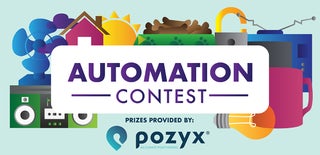Introduction: Robotics and Automation Shrinked With BABYDUINO
Let's Shrink Arduino Projects, Robotics and Automation You all did with Arduino UNO. Now There is Shrinkified Version, Fully Reliable, Tested and Open Source which allows full 8K Memory. Afterall Every Byte is Necessary. Presented Here is the Working of BABYDUINO Board. The Board needs Arduino or USB to TTL Programmer or Bootloader to Program It. However it is extremely Easy. It is Compatible with Arduino IDE.
Arduino is a Big Board With Large Number of pins but what if you don't need that pins and want something tiny, then You Need This Board and you gotta love it while Using. Make Robots, Play with it, sense, Make Weather Station , Make Small Games and much more in this Shrinkified Baby Arduino.
You can help me and Back My Campaign here.
Step 1: About BABYDUINO
Arduino Is Extremely Useful and powerful Development Board. Suppose You Just want to interface RGB LED, or just LED using a button, then just use Babyduino for prototyping this small systems taking least space. Suppose You are making multitasking robot then there is always small space for prototyping. This Board can be used for controlling Motors Or LEDs. Some Specifications are mentioned Below:
- Open Source Hardware!
- Use with standard Arduino IDE or AVR StudioAllows
- FULL use of the 8K memory on the chip (no bootloader needed!)
- All pins broken out for use.
- Reset button on board
- Easy to assemble due to through hole construction
- Easy to replace chip.
- Also easy to take your programmed chip and put it in a final more permanent project. Small and Inexpensive Design.
You Can Back this Innovation as I am running a Campaign on Indiegogo: https://www.indiegogo.com/projects/babyduino-shrinkify-your-arduino-projects-innovation/x/17426946#/
Step 2: BABYDUINO BOM(Bill of Materials)
1. ATTiny 13A
2. Button
3. 2 x 4 pin Header
4. 220 Ohms Resistor
5. LED
Step 3: Making BABYDUINO
Assemble the Components On PCB Or Breadboard as shown in Circuit Diagram. Here we are Using ATTiny 13 Micro controller. A reset Button is Placed along Pin1(Reset) and GND of ATTiny. Headers are placed for each and every pin of ATTiny which makes it easier to connect it with Arduino or any other Modules or Sensors. LED is Interfaced at PB1 as shown in Circuit Diagram.
Step 4: Working and Connections
BABYDUNO is Compatible With Arduino IDE.
We shall use Arduino UNO as USB to TTL Converter and Upload Program using Arduino As ISP.
Connections:
D10 of Arduino to Reset of BABYDUINO
D11 of Arduino to PB0 of BABYDUINO
D12 of Arduino to PB1 of BABYDUINO
D13 of Arduino to PB2 of BABYDUINO
GND of Arduino to GND of BABYDUINO
3.3V of Arduino to VCC of BABYDUINO
Step 5: Controlling Servo Motor Using BABYDUINO
Here, Now Onwards We will use 9V Battery To Power BABYDUINO. We will use 7805 Voltage Regulator IC to Convert 9v to 5v suitable for ATTiny.
Controlling a servo motor directly from the BABYDUINO is quite easy. However, a servo motor may require significantly more current than the it can provide. The following example uses a standard sized servo (without any load).
Connections:
Connect the black wire from the servo to the GND pin on the BABYDUINO or 7805 IC
Connect the red wire from the servo to the +5V pin on the BABYDUINO
Connect the yellow or white wire from the servo to a digital pin on the BABYDUINO. I selected PB1.
Upload Blink Sketch Provided to see it Running!
Attachments
Step 6: Controlling a DC Motor
Try plugging one wire directly into pin PB1, and one directly into ground, to start with. Not much going on there, eh? Little haptic motors (and their twins, cell-phone vibe motors) will run perfectly happily on the small power supply. But kick it up to small-robot standards, and you'll have to prod the motor to get it spinning even when the power's on.
Upload Blink Sketch Provided to see it Running!
Attachments
Step 7: Using Transistor for Robotics
Now, unplug your BABYDUINO and reconfigure the circuit on a breadboard: plug one of the motor's wires into the 5V pin on your 7805 IC. Now, connect the transistor:
BASE (middle) leg to digital pin PB1
COLLECTOR to the motor's other wire.
EMITTER to a ground pin.
Upload Blink Sketch Provided to see it Running!
Attachments
Step 8: Using Sensors Like Ultrasonic Sensor
The connections are as follows:
Vcc to 5V Pin of the BABYDUINO.
Gnd to Gnd Pin of the BABYDUINO.
Trig to Digital Pin PB2.
Echo to Digital Pin PB0.
Attachments
Step 9: Thank You!
Thank You For Reading My Instructable!!
I hope You Found My BABYDUINO and Instructable Useful.
Have a Nice Day!
Thank You!!

Participated in the
Automation Contest 2017

Participated in the
Make It Move Contest 2017

Participated in the
Plastics Contest














